
Denshobi project preserving centuries-old Japanese artwork
In May 2007, new sliding doors (fusuma) were brought into Juko-in, a sub-temple of Daitokuji temple in Kyoto City, to replace the masterpieces created by Kano Eitoku (1543-1590) and his father, Shoei, that had adorned its interior for more than four centuries. Even when scrutinized up close, the new sliding doors looked identical to the original fusuma paintings. Their stunning quality made Kodo Onozawa, chief priest of Juko-in, heave a sigh of relief.
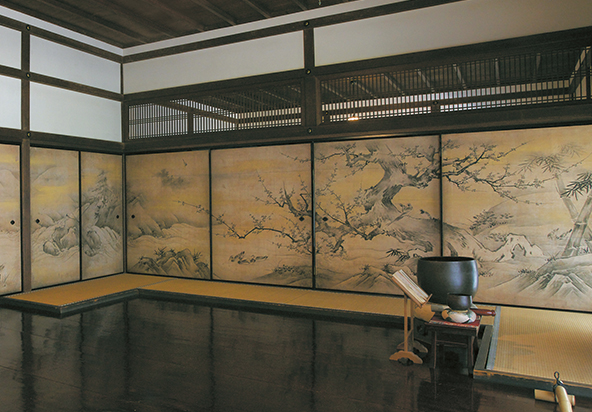
|
|---|
| Fusuma paintings “Kacho Zu” by Kano Eitoku, national treasure of Daitokuji Tacchu Juko-in temple in Kyoto |
Like his predecessors, Onozawa shouldered the heavy responsibility of protecting the fusuma paintings designated as Japanese national treasures, while living and carrying out his duties alongside the precious artwork. But, after the artwork degraded due to insect damage and changes in the environment such as increases in toxic substances and ultraviolet rays, the temple decided to entrust the paintings to the Kyoto National Museum for repair and storage. Juko-in then asked Dai Nippon Printing Co., Ltd.(DNP) to make replicas of the drawings created by Eitoku, one of the greatest Japanese painters from the Kano school, whose dominance in the Japanese art world spanned 400 years.

|
|---|
| Fusuma paintings “Sennin Zu” by Kano Naonobu, important cultural property of Chionin temple in Kyoto |
“The chief priest told me he was relieved when he saw the replicas, a comment that remains etched in my memory 10 years on,” said Masaki Imai, who leads DNP's Denshobi project of creating high-precision replicas of cultural assets to allow the originals to be preserved in storage or at museums. “Indeed, the replicas were reflected on impeccably polished wooden floors, just like the originals, projecting a majestic air.”
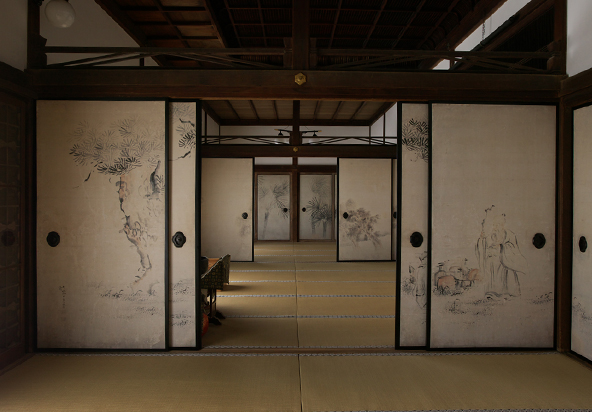
|
|---|
| Fusuma paintings “Kinkishoga Zu” by Ikeno Taiga and “Inchuhassen Zu” by Yosa Buson of Jishoji temple in Kyoto |
In December 1999, the DNP Group started developing technologies for the Denshobi project, based on the group's printing and digital archiving expertise. The replicas at Juko-in represented its second undertaking following a project completed three months earlier to duplicate and replace 50 fusuma and wall paintings by Maruyama Okyo (1733-1795) at the Okyokan building of the Tokyo National Museum. Since then, about 400 old drawings on fusuma, walls, ceilings and hanging scrolls, including some designated as national treasures and important cultural assets, have been replicated. The project's clients include Jishoji temple (Kyoto City), Enkakuji temple (Kamakura City), Muryoji temple (Wakayama Prefecture), Ikkyuji temple (Kyoto Prefecture), Chionin temple (Kyoto City), Gichuji temple (Shiga Prefecture) and Hayashibara Museum of Art (Okayama City).
Seeking ways to replicate paintings on gold leaf
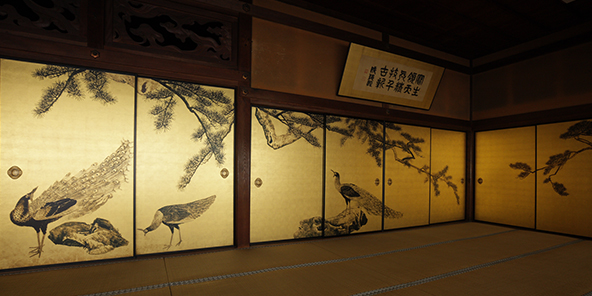
|
|---|
| Fusuma paintings “Matsunikujaku Zu” by Maruyama Okyo, important cultural property of Daijoji temple in Hyogo Prefecture |
Imai, whose university major was mechanical engineering, first got involved in Denshobi in 2002, two years after he joined DNP. He was picked for the project because of his vast experience in evaluating inks and other materials for printing operations, but in this project, he would evaluate much more expensive materials, such as washi paper, silk and gold leaf.
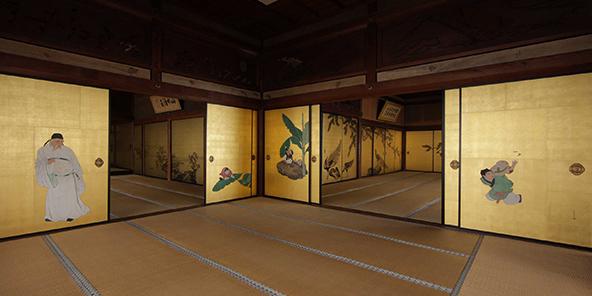
|
|---|
| Fusuma paintings “Kakushigi Zu” by Maruyama Okyo, important cultural property of Daijoji temple in Hyogo Pref. |
His first assignment was to find washi paper suitable for printing and to oversee the development of gold inks that he hoped to use to recreate drawings on gold leaf, a distinctive feature of 63 fusuma and wall paintings by Maruyama Okyo and his proteges at Daijoji temple in Kami Town, Hyogo Prefecture.

|
|---|
| Golden cloud expressing 3D effect |
DNP and a long-time partner company jointly developed a printable washi paper relatively easily, but it hit a snag with the development of gold inks. “These inks were unable to reproduce the sparkle of gold leaf,” Imai recalled. “We then turned to gold leaf made in the same way as it was in the Edo period” (1603-1867).
In collaboration with a Kyoto gold leaf maker with a 300-year history, DNP finally developed a technology to print precise images on gold leaf (later patented) after a process of trial and error. In total, DNP spent five years developing materials necessary for the Daijoji project, but the efforts, Imai said, paid off. When replicas of the Okyo paintings were installed at Daijoji in June 2009, Chief Priest Shindo Hasebe said he was "deeply moved to see the replicas at last after the long (seven-year) process." Members of the temple's danka support body and Kami residents who gathered at the temple were allowed to enter the rooms adorned by the replicas, giving them a chance to closely observe them in the same space that the originals had been located.
“Without exception, my clients thanked me. Some even shed tears of joy because they could carry out their duties the same way as before in the same environment,” Imai said. “This was the most rewarding part of my work.”
Collecting and processing digital data essential to ensure high precision

|
|---|
| Non-contact high definition scanning |
The project team has three members: Imai is in charge of speaking with temples, museums and other clients, and Masahiro Sugimine and Susumu Ishido—both from DNP Communication Design Co., Ltd.—gather and process digital data of the artwork.
Sugimine collects data by using a high-precision camera or a special scanner when the artwork is bigger in size. Collecting digital data requires utmost care: No instrument should touch its surface, and lighting should not emit ultraviolet rays, or heat—two factors that can damage old art pieces.
Ishido processes the gathered data. Four photos are taken when capturing a 90-centimeter by 180-centimeter fusuma door. When the photos are merged into one image, it usually contains more than 400 million pixels. Such enormous data, first processed with the color management system, must be adjusted manually to express subtle differences in gold brightness, for example, based on Ishido's extensive knowledge about Japanese arts in general and each painter's style and philosophy. In this way, each art piece's shades, brush strokes and other features are faithfully duplicated by a special inkjet printer. After a sample is meticulously checked by the temple, art supervisors and other art experts at the same location as the original was placed, replicas are printed and placed on fusuma doors and other materials.
Taking the perspective of clients
DNP has reproduced artwork in three different ways. The most popular method is to reproduce an artwork as it appears now, followed by one to duplicate an art piece based on colors and other conditions of the best-preserved parts of a painting. The least common way is to recreate the artwork's original state, which can be controversial because its success depends on the skills of a conservator.
Whichever method is used, making replicas is an expensive process, especially when gold leaf is involved. Duplicating more than 100 fusuma paintings for a temple could cost as much as several hundred million yen.
“My company might not like me saying this, but I think about a client's challenges from their standpoint, not that of DNP,” Imai said. “If they don't have good storage places, I look for them. If they don't have enough financial resources to pay for the replicas, I try to find ways to generate funds such as through sales of goods produced capitalizing on the digital data of their artwork.”
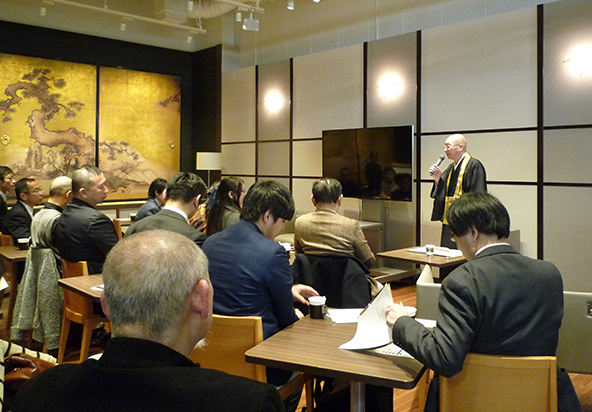
|
|---|
| A lecture on Kyoto Cultural Heritage |
In the future, Imai hopes to make Denshobi a revenue-generating operation both for clients and DNP by holding events that will feature masterpiece replicas and 4K ultra-high definition videos of temples and shrines, and selling goods made based on DNP's digital archiving technologies. As a precursor, DNP held a lecture meeting on Kyoto's cultural assets at Nijo Castle and elsewhere. “Ideally people would visit those temples in person, but such events may be of interest to those who are unable to visit them but want to see these cultural assets.”
Venturing on the global stage

|
|---|
| As part of the DNP “Denshobi” project, the high definition replica of “Rakuchu Rakugai Zu Byobu”, important cultural property of Hayashibara Museum of Art Collection, was displayed at CeBit, Europe's biggest IT trade show held in Hanover, Germany. |
DNP is looking at overseas opportunities for the Denshobi project. At CeBit, Europe's biggest IT trade show, held in Hanover, Germany, in March 2017, the company showcased the replica of an Edo-period art piece, the left panel of Rakuchu Rakugai Zu Byobu (Folding Screen Painting of Scenes In and Around Kyoto). Imai said visitors were impressed by the replica, which depicts famous temples and thousands of people of Kyoto.
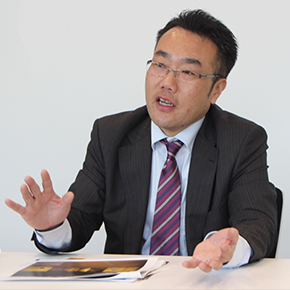
|
|---|
Making replicas of famed oil paintings is another business field that DNP aspires to enter. “We have experience in printing images on canvas and are able to replicate the thickness of oil paints by employing our overprint technology,” Imai said. “DNP has introduced an art viewing multimedia system in collaboration with the Louvre Museum, so we have extensive knowledge about Western artwork. That could open an avenue for DNP to expand its global operations in the cultural sphere.”
- *DNP department names, product specifications and other details are correct only at the time of writing. They are subject to change without prior notice.
July 14, 2017 by DNP Features Editorial Department


